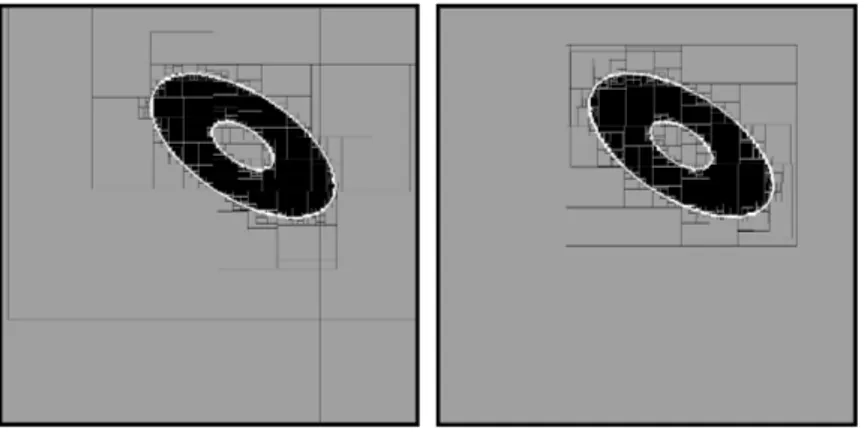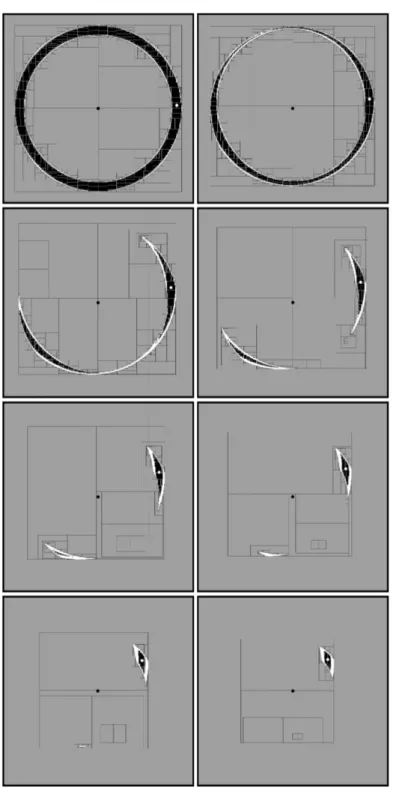HAL Id: hal-01236498
https://hal.archives-ouvertes.fr/hal-01236498
Submitted on 1 Dec 2015HAL is a multi-disciplinary open access
archive for the deposit and dissemination of sci-entific research documents, whether they are pub-lished or not. The documents may come from teaching and research institutions in France or abroad, or from public or private research centers.
L’archive ouverte pluridisciplinaire HAL, est destinée au dépôt et à la diffusion de documents scientifiques de niveau recherche, publiés ou non, émanant des établissements d’enseignement et de recherche français ou étrangers, des laboratoires publics ou privés.
Separator Algebra for State Estimation
Luc Jaulin
To cite this version:
Luc Jaulin. Separator Algebra for State Estimation. SMART 2015, Université de Manchester, Sep 2015, Manchester, United Kingdom. �hal-01236498�
Separator Algebra for State Estimation
Luc Jaulin, ENSTA-Bretagne, LabSTICC.1
Introduction
Consider the following state estimation problem [Jau15] (i) ˙x (t) = f (x (t)) , t ∈ R
(ii) g (tk) ∈ Y (k) , k ∈ N (1)
Our objective is to find an inner and an outer approximation of the set X (t) of all state vectors that are consistent with (1) at time t. If we define by flow map ϕt1,t2 as follows:
x(t1) = x1 and ˙x (t) = f (x (t)) ⇒ x2= ϕt1,t2(x1) . (2)
The set of all causal feasible states at time t is defined by X(t) =
tk≤t
ϕtk,t◦ g
−1(Y (k)) . (3)
In this paper, we show how it is possible to find both an inner and an outer approximations for X(t). Some existing methods are able to find an outer approximation [KJWM99] [GRMA13], but, to my knowledge, none of them is able to get an inner approximation. The main idea is to copy a classical contractor approach [CJ09] for state estimation, but to use separators [JD14] instead of contractors.
2
Separators
In this section, we present separators and show how they can be used by a paver in order to bracket the solution sets. An interval of R is a closed connected set of R. A box [x] of Rn is the Cartesian
product of n intervals. The set of all boxes of Rn is denoted by IRn
. A contractor C is an operator IRn→ IRn such that C([x]) ⊂ [x] and [x] ⊂ [y] ⇒ C([x]) ⊂ C([y]). A set S is consistent with the contractor C (we will write S ∼ C) if for all [x], we have C([x]) ∩ S = [x] ∩ S. A separator S is pair of contractors Sin, Sout such that, for all [x] ∈ IRn
, we have Sin([x]) ∪ Sout([x]) = [x]. A set S is
consistent with the separator S (we write S ∼ S), if S ∼ Sout and S ∼ Sin. where S = {x | x /∈ S}.
Using a separator inside a paver we can easily to classify part of the search space that are inside or outside a solution set S associated with S.
The algebra for separators is a direct extension of contractor algebra [CJ09]. If Si = Siin, Siout , i ∈
{1, 2} are separators, we define
S1∩ S2 = S1in∪ S2in, S1out∩ S2out (intersection)
S1∪ S2 = S1in∩ S2in, S1out∪ S2out (union)
f−1(S1) = f−1(S1in), f−1(S1out) (inverse)
If Si are sets of Rn, we have [JSD14] (i) S1∩ S2 ∼ S1∩ S2 (ii) S1∪ S2 ∼ S1∪ S2 (iii) f−1(S 1) ∼ f−1(S1) . (5) Interval analysis [Moo66] [KK96] combined with contractors [CJ09] has been shown to be able to give an outer approximation of set. For the inner subpaving, the De Morgan rules make it possible to express the complementary set X of X. Then, basic contractor techniques can be used to get an inner characterization X−. Now, the task is not so easy and the role of separators is to make it
automatic.
3
Transformation of separators
A transformation is an invertible function f such as an analytical expression if known for both f and f−1. The set of transformation from Rn to Rn is a group with respect to the composition ◦.
Symmetries, translations, homotheties, rotations, . . . are linear transformations.
Theorem. Consider a set X and a transformation f . Denote by [f ] and f−1 two inclusion functions
for f and f−1. If S
Xis a separator for X then a separator SYfor Y = f (X) is
[y] → [f ] ◦ SXin◦ f−1 ([y]) ∩ [y] , [f ] ◦ SXout◦ f−1 ([y]) ∩ [y] (6)
or equivalently f(X) ∼ [f ] ◦ Sin X ◦ f −1 ∩ Id, [f ] ◦ Sout X ◦ f −1 ∩ Id (7)
where Id is the identity contractor.
Remark. The separator defined by (6) corresponds to what we call the transformation of a separator by f and we write SY= f (SX). As a consequence, thanks to the theorem, we can add to
(5) the property
(iv) f(X) ∼ f (SX) .
which will be used later for our state estimation problem. Proof. The separator SY is equivalent to Y = f (X) if
Sout Y ([y]) ∩ Y = [y] ∩ Y Sin Y([y]) ∩ Y = [y] ∩ Y. (8) Since Sout
Y ([y]) ⊂ [y] and SYout([y]) ⊂ [y], it suffices to prove that
(i) Sout
Y ([y]) ⊃ [y] ∩ Y
(ii) Sin
Y([y]) ⊃ [y] ∩ Y.
(9) Let us first prove (i). We have
[y] ∩ Y = f f−1([y]) ∩ f−1(Y) f is bijective
= f f−1([y]) ∩ X X= f−1(Y)
⊂ f f−1 ([y]) ∩ X f−1 is an inclusion function for f−1
⊂ f (Sout
X f−1 ([y]) ) SXout is a contractor for X
⊂ [f ] ◦ Sout
X ◦ f−1 ([y]) [f ] is an inclusion function for f
Thus [y] ∩ Y ⊂ [f ] ◦ Sout
X ◦ f−1 ([y]) ∩ [y] = SYout([y]). Let us now prove (ii). We have
[y] ∩ Y = f f−1([y]) ∩ f−1 Y f is bijective
= f f−1([y]) ∩ X X= f−1 Y
⊂ f f−1 ([y]) ∩ X f−1 is an inclusion function for f−1
⊂ f (Sin X f −1 ([y]) ) Sin X is a contractor for X ⊂ [f ] ◦ Sin X ◦ f
−1 ([y]) [f ] is an inclusion function for f
(11)
Thus [y] ∩ Y ⊂ [f ] ◦ Sout
X ◦ f−1 ([y]) ∩ [y] ∩ Y = SYin([y]) which terminates the proof.
Example. Consider the constraint 2 0 0 1 cos α sin α − sin α cos α y1− 1 y2− 2 ∈ [1, 3] . (12)
If we apply an efficient forward-backward contractor in a paver, we get the contractions illustrated by the paving of Figure 1, left. Now, if we take
x1 x2 = 2 0 0 1 cos α sin α − sin α cos α y1− 1 y2− 2 = f −1(y) (13) or equivalently y1 y2 = cos α − sin α sin α cos α 1 2 0 0 1 x1 x2 + 1 2 = f (x) , (14) we get y= f (x) , and x ∈ [1, 3] . (15) An optimal separator SX can be built for x and the separator transform provides us a separator
SY for Y. As illustrated by Figure 1, right, the resulting separator SY is more efficient than the
classical one based on forward-backward contractors. Note that in case we are not able to have an inner approximation for f−1, the problem of finding an inner approximation of the image of a set f(X) becomes much more difficult. See, e.g., [VJVS05] [GJ10].
4
State estimation
If SX(0) is a separator for X (0) and if SY(k) are separators for Y (k), then a separator for the set
X(t) defined by (3) is SX(t)= tk≤t ϕtk,t◦ g −1 S Y(k) . (16) In this formula, g−1 S
Y(k) is a separator. Due to the fact that ϕtk,t is bijective and that we are
able to find an inclusion function for ϕtk,t and ϕ
−1
tk,t [RN11], the separator ϕtk,t◦ g
−1 S Y(k) is
clearly defined using the separator transform. To illustrate the method, let us consider a robot described by ˙ x(t) = v (t) cos θ (t) v (t) sin θ (t) (evolution) x(tk) ∈ y (tk) + [−0.3, 0.3] , tk= 0.1 · k, k ∈ N (observation) (17)
Fig. 1.Left. Contractions obtained using a classical forward-backward propagation; Right. Contractions obtained using the separator transform. The frame corresponds to the box [−6, 6]2.
where v (t) and θ (t) are measured with an accuracy of ±0.03. The observation equation is due to the fact that the robot measures every 0.1 sec its distance to the origin with an accuracy of ±0.3. The actual (but unknown) trajectory for the robot is
x(t) = 2 + 3 cos t
2 sin t . (18)
For t ∈ 0.2 ∗ k, k = 0, . . . , 7, the sets X (t) obtained by our observer are represented on Figure 2. Black boxes are inside X (t), grey boxes are outside and the white boxes cover the boundary. For t = 0, X (t) is a ring which becomes a small set for t = 1.4 once the robot has moved sufficiently. The fact that the white area covering the boundary becomes thick is mainly due to the state errors inside the evolution equation.
References
[CJ09] G. C L. J . Contractor Programming. Artificial Intelligence 173, 1079—1100 (2009).
[GJ10] A. G L. J . Inner Approximation of the Range of Vector-Valued Functions.
Reliable Computing pages 1—23 (2010).
[GRMA13] A. G , B. R , L. M , F. A . An Introduction to Box Particle Filtering. IEEE Signal Processing Magazine 30(1), 166—171 (2013).
[Jau15] L. J . “Automation for Robotics”. ISTE editions (2015).
[JD14] L. J B. D . Separators: a new interval tool to bracket solution sets; application to path planning. Engineering Applications of Artificial Intelligence 33, 141—147 (2014).
[JSD14] L. J , A. S , B. D . Inner and outer approximations of probabilistic sets. In “ICVRAM 2014” (2014).
[KJWM99] M. K "" , L. J , E. W , D. M . Guaranteed mobile robot tracking using interval analysis. In “Proceedings of the MISC’99 Workshop on Applications of Interval Analysis to Systems and Control”, pages 347—359, Girona, Spain (1999).
Fig. 2.Inner and outer approximations of the set of all feasible state vectors X (t) , for t ∈ 0, 0.2, . . . , 1.4. The frame boxes are [−6, 6]2.
[KK96] R. B. K " V. K , editors. “Applications of Interval Computations”. Kluwer, Dordrecht, the Netherlands (1996).
[Moo66] R. E. M . “Interval Analysis”. Prentice-Hall, Englewood Cliffs, NJ (1966).
[RN11] N. R ' N. N ( . Computing Reachable Sets for Uncertain Nonlinear Hybrid Systems using Interval Constraint Propagation Techniques. Nonlinear Analysis: Hybrid Systems 5(2), 149—162 (2011).
[VJVS05] P. H V , L. J , J. V , M. A. S . Inner and outer approximation of the polar diagram of a sailboat. In “workshop on Interval Analysis and Constraint Propagation for Applications (IntCP’05)”, Barcelona, Spain (2005).

